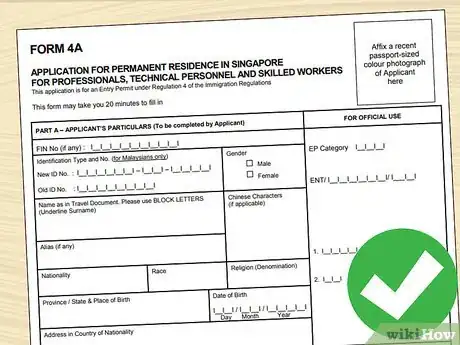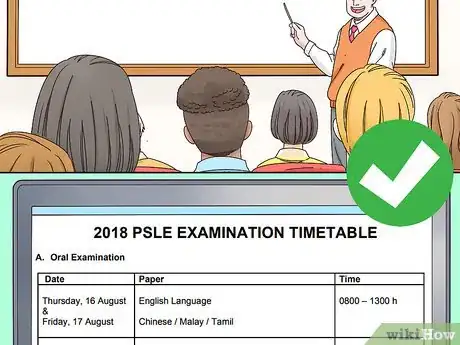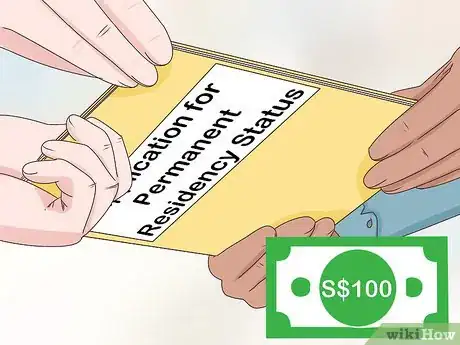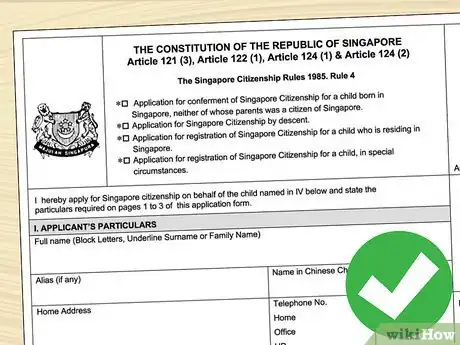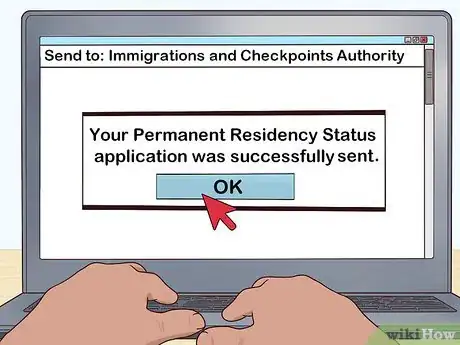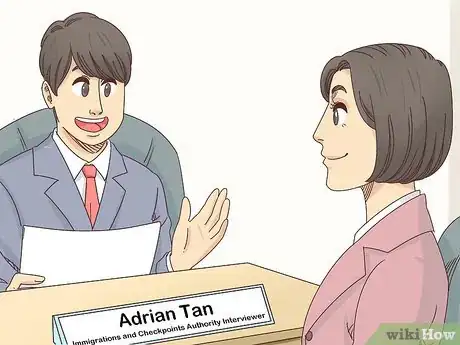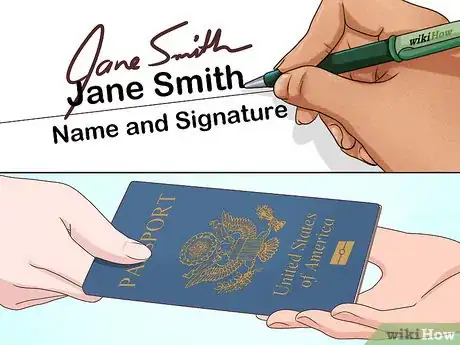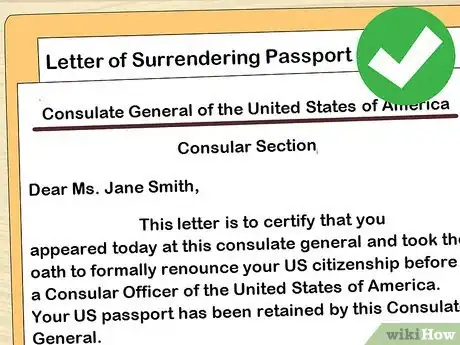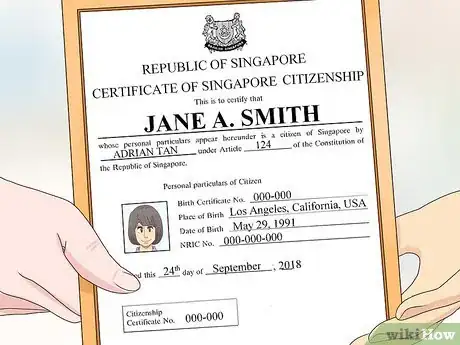This article was co-authored by wikiHow Staff. Our trained team of editors and researchers validate articles for accuracy and comprehensiveness. wikiHow's Content Management Team carefully monitors the work from our editorial staff to ensure that each article is backed by trusted research and meets our high quality standards.
This article has been viewed 22,692 times.
Learn more...
Singaporean citizenship comes with a lot of benefits worth considering: a Singaporean passport carries excellent visa-free travel around the world and the country has an alluring economy for investors and entrepreneurs. However, applying for citizenship in Singapore isn’t an easy or fast process. To become a Singaporean citizen, you have to become a permanent resident (PR), live in Singapore for 2 years, then submit your application and renounce your former nationality.
Steps
Becoming a Permanent Resident
-
1Apply under the Scheme for Professional/Technical Personnel/Skilled Workers. The most common way to become a PR is to apply as a foreign professional working in Singapore. Under this scheme, a person lives and works in Singapore for 2 years and then applies for PR status based on their employment history.[1]
- You’ll need to already be living and working in Singapore before you can apply for PR status through this scheme. It’s recommended that you wait at least a year after you’ve started working in Singapore before submitting your PR application.
- Note that you’ll need to be working a job that pays a minimum annual salary of S$3300 and that your professional skills and education, as evidenced by the industry you work in, the pedigree of your employer, and the reputation of the academic institution you’ve graduated from, will also factor into your application for PR status.
-
2Become a PR through the Scheme for Entrepreneurs. The Scheme for Entrepreneurs, otherwise known as the Global Investor Programme, aims to encourage investors who can invest large sums of money in the Singaporean economy to apply for PR status. If you’re an investor or successful entrepreneur, apply for PR status through this scheme.[2]
- Applicants for PR status through this scheme must deposit S$1.5 million with the Singaporean government to be considered.
- Although there are no educational or vocational requirements for applying for PR status under this scheme, you’ll need to provide records of the most recent 3 years of your entrepreneurial or business experience.
Advertisement -
3Apply for PR status as a foreign artist if possible. There is a third scheme for applying for PR status called the Foreign Artistic Scheme. If you have formal training, education, and experience in the visual arts, performance arts, or literary arts, consider applying for PR status through this scheme.
- Note that this scheme is intended for acclaimed artists in various fields and is the most difficult means of obtaining PR status in Singapore for most people.
-
4Attend school in Singapore and pass at least 1 national exam. If you’re still a student, you can also apply for PR status by studying in Singapore for 2 years and passing at least 1 national exam.[3]
- The national exams you have to take before applying for PR status are the Primary School Leaving Examination (PSLE) or the Singapore-Cambridge GCE for high school students.
-
5Marry a Singaporean citizen or permanent resident. Perhaps the quickest way to become eligible to apply for PR status is to marry a citizen or permanent resident of Singapore. If you have children younger than 21 with your spouse, they can also apply for PR status through this scheme.[4]
- You don’t have to have to lived in Singapore for 2 years to apply for citizenship this way. You only need to submit your PR application and wait until it is processed, which can take as little as 4 weeks.
- Note that you will need to provide an official marriage certificate when submitting your application for PR status.
- Although this isn’t guaranteed, your application may be stronger if you apply along for PR status along with your children, as the Singaporean government looks favorably on applicants maintaining close family ties in Singapore.
-
6Submit your application once you’re eligible for PR status. Once you’ve met the requirements for PR status for your particular scheme, use the government’s online portal to submit your application for PR status.[5]
- You must submit your application using the Singaporean government’s e-service: https://erep.ica.gov.sg/epr/index.xhtml. Applications for each scheme are submitted through this online portal.
- As of August 2018, there is a S$100 fee for each application for PR status.
- Make sure you assemble all the supplemental documents required by the Singaporean government for the particular scheme you’re applying through, such as your official marriage certificate, valid Immigration Pass, Work Pass, and your highest educational certificates.
- The turn-around for PR applications is roughly 4 to 6 months.
-
7Be prepared to perform mandatory service. Under Singaporean law, all male citizens and Permanent Residents must register for the National Service and perform mandatory service once they reach the age of 18. This is carried out for 2 years and can be served either in the armed forces or in the police force. Singaporean men are subject to this law until the age of 40.[6]
- Note that if you apply for PR status as a student, you have to register for the NS when you reach the age of 16.5.
- Defaulting on your mandatory service may result in a substantial fine or as much as 3 years in prison.
- As of August 2018, women do not need to perform mandatory service in the Singaporean National Service.
Applying for Citizenship
-
1Gather up supporting documents for yourself and your family. Once you’ve been a permanent resident for 2 years, you’re eligible to apply for Singaporean citizenship. Before you begin your application, make sure to gather and complete the necessary supplemental documents.[7]
- For most applicants, these documents include a Singapore Citizenship Registration Application form (SCRA Form), an Annex A form, and a Singapore Citizenship Registration on behalf of a Minor form (SCRM Form). These forms can be found on the Immigration and Checkpoints Authority website: https://www.ica.gov.sg/apply/citizenship/apply_citizenship_who.
- If you’re married, you’ll also need to provide supporting documents for your spouse, even if they’re not applying for citizenship.
-
2Submit your application materials online or in person at the ICA. Like with the PR status application, the application for citizenship can also be submitted online. If you prefer, you can also hand in your materials in person at the Immigrations and Checkpoints Authority (ICA) office.
- If you want to submit your application in person, you’ll have to make an appointment first at the ICA. Appointments can be made online through the ICA’s website.
- Note that citizenship applications can not be submitted by mail.
- The turn-around for citizenship applications is roughly 6 to 12 months. As of August 2018, there is a S$100 processing fee for each application.
-
3Conduct an interview with an ICA officer. Once your application has been submitted and processed, you’ll need to sit down to an interview with an ICA officer. The officer will question you against the information on your application and you’ll have to make a statement that all the material on your application is true.
- If you’re applying for citizenship as the spouse of a Singaporean citizen, your spouse will also have to be present for this interview.
- If your application for citizenship is also on behalf of a child, then that child may also need to appear during the interview.
-
4Renounce your former foreign citizenship at the relevant embassy. As part of the process of becoming a Singaporean citizen, you’ll need to renounce any other national citizenship. Once you receive notice that your citizenship application has been accepted, head to the relevant embassy in Singapore and renounce your former citizenship ties.
- You’ll need to bring your former nation’s passport with you to the embassy. There, you’ll sign an oath of renunciation in the presence of a consular officer and hand over your passport.
- This process can also be carried out at the High Commission in Singapore.
- Note that you may have to pay a fee to renounce your citizenship, depending on your nationality. Consult with the consular officers of your nation’s embassy to determine whether you need to pay a fee as part of your renunciation.
-
5Submit your final registration documents and take your loyalty oath. Bring your letter of renunciation from your former embassy and letter stating the surrender of your passport to the Citizen Services Centre in Singapore. There, you’ll pay a fee, complete your citizenship registration, receive your passport, and swear an oath of allegiance.
- As of August 2018, you’ll need to pay a S$70 fee for your registration, S$10 for your identity card, and $80 for your passport.
- The oath you’ll swear is the “Oath of Renunciation, Allegiance and Loyalty” and it must be sworn in front of the Commissioner of Oaths.
-
6Attend the National Citizenship Ceremony to receive your certificate and ID card. The final step in the process is to attend a citizenship ceremony at a later date. You’ll be given your identity card and citizenship certificate at the ceremony and be officially recognized as a Singaporean citizen.
- The National Citizenship Ceremony is held in August of each year.
- Note that you’re required to attend this ceremony, although children under the age of 6 are exempt.
Warnings
- Note that if you’re a man, you’ll also be required to perform mandatory service in the military once you become a Singaporean citizen.⧼thumbs_response⧽
- Singapore doesn’t allow its citizens to hold dual citizenship. Be sure you’re willing to renounce your current citizenship before going through with applying for Singaporean citizenship.⧼thumbs_response⧽
References
- ↑ https://www.ica.gov.sg/reside/PR/apply
- ↑ https://www.mfa.gov.sg/content/mfa/overseasmission/canberra/consular_services/applicaton_for_permanent_residency.html
- ↑ https://www.ica.gov.sg/cms/files/forms/Explanatory%20Notes%20and%20Document%20List%20(for%20foreign%20students).pdf
- ↑ https://www.mfa.gov.sg/content/mfa/overseasmission/canberra/consular_services/applicaton_for_permanent_residency.html
- ↑ https://www.ica.gov.sg/apply/PR/apply_PR_who
- ↑ https://www.ica.gov.sg/cms/files/forms/Explanatory%20Notes%20and%20Document%20List%20(for%20foreign%20students).pdf
- ↑ https://www.ica.gov.sg/apply/citizenship/apply_citizenship_who
